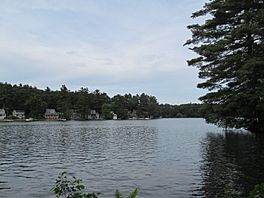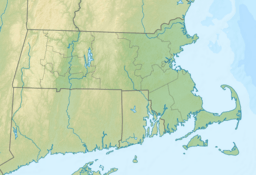Lake Boon facts for kids
Quick facts for kids Lake Boon |
|
|---|---|

Lake Boon
|
|
| Location | Middlesex County, Massachusetts, U.S. |
| Coordinates | 42°24′11″N 71°30′05″W / 42.40306°N 71.50139°W |
| Type | Reservoir |
| Primary outflows | Assabet River |
| Catchment area | 1,690 acres (680 ha) |
| Basin countries | United States |
| Max. length | 1.5 mi (2.4 km) |
| Surface area | 163 acres (66 ha) |
| Average depth | 10.7 ft (3.3 m) |
| Max. depth | 23 ft (7.0 m) |
| Surface elevation | 187 ft (57 m) |
| Settlements | |
Lake Boon is a beautiful lake in eastern Massachusetts. It covers about 163 acres (0.66 square kilometers) and is located in the towns of Stow and Hudson, Massachusetts. This lake has been an important part of these communities for a very long time.
The lake was originally named "Boon Pond." It was named after Matthew Boon, an explorer from Charlestown, Massachusetts. He arrived in the area in 1660. Matthew Boon was one of the first settlers in Stow. He was killed near the lake around February 14, 1676. In 1883, a monument was built to remember him.
Contents
Lake Boon's History
Henry David Thoreau's Visit
On September 4, 1851, a famous writer named Henry David Thoreau visited Boon Pond. He wrote about his trip in his journal, calling the entry "A Walk to Boon's Pond in Stow."
Thoreau noted that the pond's shores were "handsome enough." He also observed that the water was "shallow and muddy looking." He mentioned that the maples around the lake were starting to turn red, and that many people fished there.
How Lake Boon Grew
Lake Boon is made up of four connected sections, called basins. The first basin was the original part of the lake. It is the largest section and is completely within Stow.
In 1847, Amory Maynard bought the water rights to Boon Pond. He built a dam to make the pond bigger. His goal was to create a larger water supply for the Assabet Woolen Mill in Maynard. This meant the pond would be large after spring snowmelt, then shrink as water was used by the mill in summer. Later, when the mill started using coal power, Lake Boon's water was no longer needed. This allowed the lake to keep a more steady water level.
The lake's expansion reached into areas once known as Ramshorn Meadow and Ramshorn Swamp. The meadow became the second basin, and the swamp became the third and fourth basins. This growth helped people see the water body as a lake, not just a pond. Today, Lake Boon is about 163 acres (0.66 square kilometers) in size and 1.5 miles (2.4 kilometers) long. The first basin is the deepest, reaching about 23 feet (7 meters). The other basins are shallower: the second is about 10 feet (3 meters) deep, the third is 7 feet (2 meters) deep, and the fourth is only 4 feet (1.2 meters) deep.
The Golden Age of Lake Boon
Towards the end of the 1800s, Lake Boon became a very popular summer vacation spot. It was easy to reach because two railroad lines ran nearby. These lines came from Boston, making the lake a great escape for people living in the city. During this time, Lake Boon had a hotel, many clubs, two post offices, churches, and local stores.
To help visitors get around, a ferry service started around 1900. A steamship called the Cleo carried passengers between Whitman’s Crossing in Stow and Ordway Station in Hudson. In 1910, a gas-powered ferry named the Princess took over the route.
When cars became common, people could travel longer distances more easily. Lake Boon became less popular as a vacation spot. Instead, more people started living there permanently. With fewer visitors, the hotel eventually closed down.
Lake Boon Today
Today, Lake Boon is still a very important part of the Stow and Hudson communities. In the summer, it's a popular place for camps and swimming lessons.
Pine Bluffs, the town beach in Stow, is located on the first basin. It recently added new picnic tables and grills. This makes it a great place for families to spend the day. To use Pine Bluffs Beach, you need a pass. Residents and non-residents can buy a season pass. Only residents can buy a day pass.



